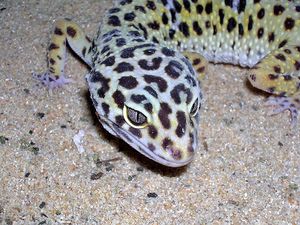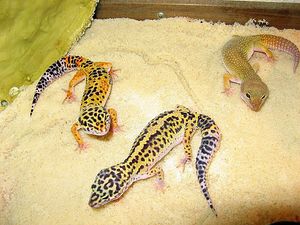Leopard Gecko
| This article has been peer reviewed but is awaiting expert review. If you would like to help with this, please see more information about expert reviewing. |
Scientific name: Eublepharis macularius
Description
Leopard geckos in general are terrestrial. Adults can attain a length just over 20 cm. Hatchlings have a total length of about 8 cm.
The common name, leopard gecko, is very appropriate. Most leopard geckos have a yellow background with irregular black to purple spots. Juveniles have a predominantly striped pattern that fades to the spotted pattern with age. The underside of the body is white. The original tail is segmented and acts as a fat store. The feet do not have any clinging lamellae and the toes end in a small claw. Unlike many other geckos, they have moveable eyelids and are able to close their eyes.
There is slight sexual dimorphism between the males and females. Males are larger, heavier in the neck region and have a V-shaped row of preanal pores. There are hemipenile swellings at the base of the tail. Females lack preanal pores and hemipenile bulges but may have preanal pores. Sex cannot be easily determined until the geckos reach 12.5-15 cm in length. Most geckos sold in pet shops are females.
Range
Leopard geckos are found in Iran, Afghanistan, Pakistan, and north-western India in dry to semi-dry desert regions. During daylight these animals hide beneath rocks or in holes in the ground.
Diet
Leopard geckos are largely insectivorous and suitable food includes crickets, small locusts, waxmoth larvae, mealworms (Tenebrio molitor) and nestling mice. A staple diet of crickets along with occasional waxworms and mealworms make a good diet. Adult geckos can also be fed an occasional pinkie mouse.
Juveniles can be feed every day and adults every day or every other day (four food items per feeding is usually sufficient for adults) These geckos do not rely on UV radiation for their vitamin D3/Ca metabolism, but must obtain all their nutritional requirements from their food supply. Supplementation is therefore a must. Insects should be both nutrient loaded and dusted with a supplement.
If possible feed in a separate container so that ingestion of the substrate is minimised. If feeding within their enclosure any uneaten food should be removed.
Enclosure
A dry vivarium suitable for ground dwelling species is appropriate. The enclosure should be a purpose built vivarium or aquarium with a screen top. The minimum size for a single individual is 60 x 30 x 30 cm and for a pair or trio is 90 x 38 x 30 cm. The substrate can be a fine grade of sand. Smaller leopard geckos may eat the sand and become impacted so an alternative is paper towelling or newspaper, which is cheap and easily changed.
Rocks, branches and logs can make the vivarium more natural looking and they provide places to climb. Cork barks and half flowerpots placed in various locations can act as hide boxes or shelters. A separate hide box is recommended for each lizard. To facilitate shedding one shelter should be kept humid by spraying or by keeping damp vermiculite within the shelter. Ensure however that the overall cage does not become too wet or humid.
A small shallow water dish, into which the geckos can walk, should be sited at the cooler end, with fresh water provided daily. Plants are not an essential feature of the set-up but various succulents may be used (e.g. Sansevieria spp. and Haworthia fasciat).
These geckos are semi-nocturnal and non-illuminating heat sources are ideal. High temperature heaters such as ceramics will require screening and thermostatic control. Incandescent bulbs (40W) can be used over specific basking areas to provide further heat. A thermometer should be used to monitor the temperature of these basking areas versus the ambient air temperature in the vivarium. Alternatively a simple spotlight (with the appropriate wattage bulb) used without a heating mat can provide both daytime light and heat. A photoperiod of about 12 hours is adequate. At night, low wattage red incandescent light bulbs can be used for heating.
Since Leopard geckos are nocturnal they do not have any special lighting requirements as far as vitamin D3/calcium metabolism is concerned and no special UV lighting is required. Leopard geckos are especially active at night and will appreciate open areas to roam and therefore the vivarium must not be too cluttered.
If keeping a group of Leopard geckos, keep one male and two or more females. Two males kept together will not tolerate one another.
Temperature
Create a temperature range of 25-29ºC for daytime with a basking place of up to 34ºC. Night-time temperatures should not fall below 20ºC.
Literature Search
Use these links to find recent scientific publications via CAB Abstracts (log in required unless accessing from a subscribing organisation).
Leopard Gecko (Eublepharis macularius) publications


